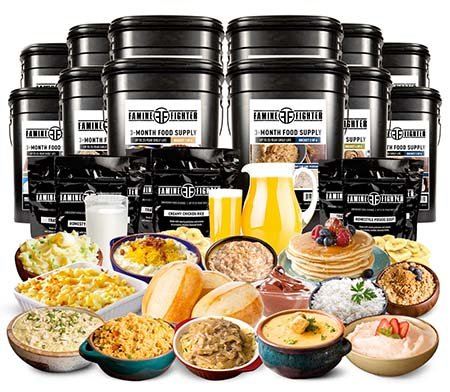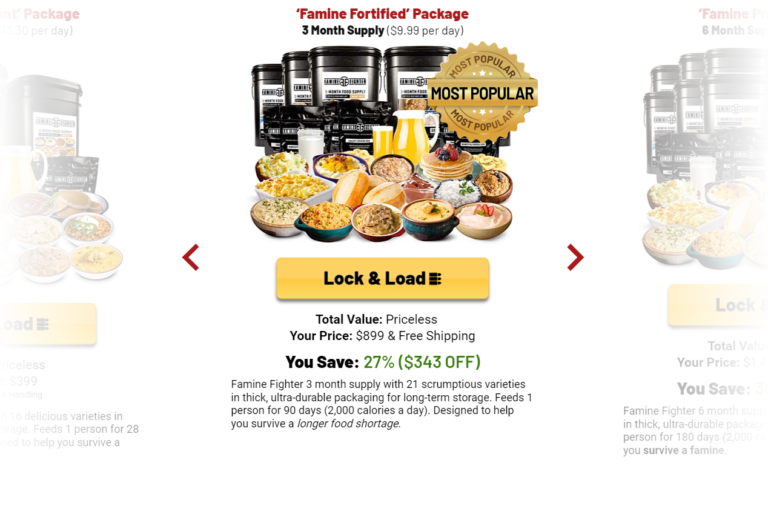New York 28 March, 2024 [Updates]: Preparing survival food involves selecting shelf-stable, nutritious ingredients and creating meals that can be easily stored, transported, and consumed during emergencies or outdoor adventures. Here’s a step-by-step guide on how to prepare survival food:
🛒𝐒𝐇𝐎𝐏 𝐍𝐎𝐖: Click Here
1. Gather Essential Ingredients:
- Stock up on long-lasting staples such as rice, pasta, beans, canned goods (vegetables, fruits, meats), dried fruits and nuts, oats, flour, sugar, salt, spices, and cooking oil.
- Include protein sources like canned tuna, chicken, or beans, as well as jerky or protein bars.
- Consider dietary needs and preferences, including gluten-free, dairy-free, or vegetarian options, and include suitable ingredients.
2. Choose Portable Cooking Equipment:
- Invest in lightweight, portable cooking gear such as a camping stove, portable grill, or solar oven.
- Pack essential cooking utensils like a can opener, knife, cutting board, spatula, pot, and pan.
- Include fuel sources such as propane canisters, charcoal, or firewood for cooking.
3. Plan Simple and Nutritious Meals:
- Focus on meals that are easy to prepare, require minimal cooking time, and provide essential nutrients.
- Create meal plans that include a balance of carbohydrates, proteins, healthy fats, vitamins, and minerals.
- Examples of survival meals include:
- Rice and beans with canned vegetables and spices.
- Pasta with canned tomato sauce, canned meat or beans, and dried herbs.
- Oatmeal with dried fruits, nuts, and honey.
- Protein bars or trail mix for quick snacks on the go.
- Instant soups or stews made with canned ingredients.
4. Practice Safe Food Handling:
- Wash hands thoroughly before handling food and use clean utensils and surfaces for cooking.
- Keep perishable foods refrigerated or cool using ice packs if possible.
- Use food storage containers or resealable bags to store leftovers or partially used ingredients.
5. Store Food Properly:
- Store dry goods in airtight containers or packaging to protect them from moisture, pests, and spoilage.
- Label containers with contents and expiration dates for easy identification and rotation.
- Keep food storage areas cool, dry, and dark to extend shelf life.
6. Rotate and Refresh Supplies:
- Regularly check and rotate your survival food supplies to ensure freshness and replace expired items.
- Update your emergency food supply based on changing needs, seasonal availability, and dietary preferences.
7. Learn Basic Cooking Skills:
- Familiarize yourself with basic cooking techniques such as boiling, simmering, sautéing, and baking.
- Practice cooking meals using portable equipment and alternative fuel sources (e.g., campfire cooking).
- Experiment with different flavor combinations and adapt recipes to suit available ingredients.
8. Consider Water and Hydration:
- Include water purification tablets, filters, or a portable water filtration system in your survival kit to ensure access to safe drinking water.
- Stay hydrated by drinking plenty of water throughout the day, especially in hot or strenuous conditions.
9. Plan for Emergency Situations:
- Create an emergency meal plan with ready-to-eat foods that require no cooking or preparation, such as canned goods, energy bars, and dried fruits.
- Include emergency supplies like first aid kits, flashlights, batteries, and communication devices in your survival kit.
10. Practice and Adapt:
- Regularly practice preparing and cooking survival meals in different scenarios, such as camping trips or simulated emergencies.
- Be flexible and adapt your meal plans based on available ingredients, resources, and cooking facilities during emergencies.
By following these steps and being prepared with essential ingredients, cooking equipment, and basic cooking skills, you can effectively prepare survival food that is nutritious, portable, and suitable for emergency situation or outdoor adventures.
Here, Famine Fighter Survival Food Kit 1 year supply with 16 scrumptious varieties in thick, ultra-durable packaging for long-term storage. Feeds 1 person for an entire year (1,800 calories a day). Designed to help you survive a long term famine – and give your family true peace of mind.






